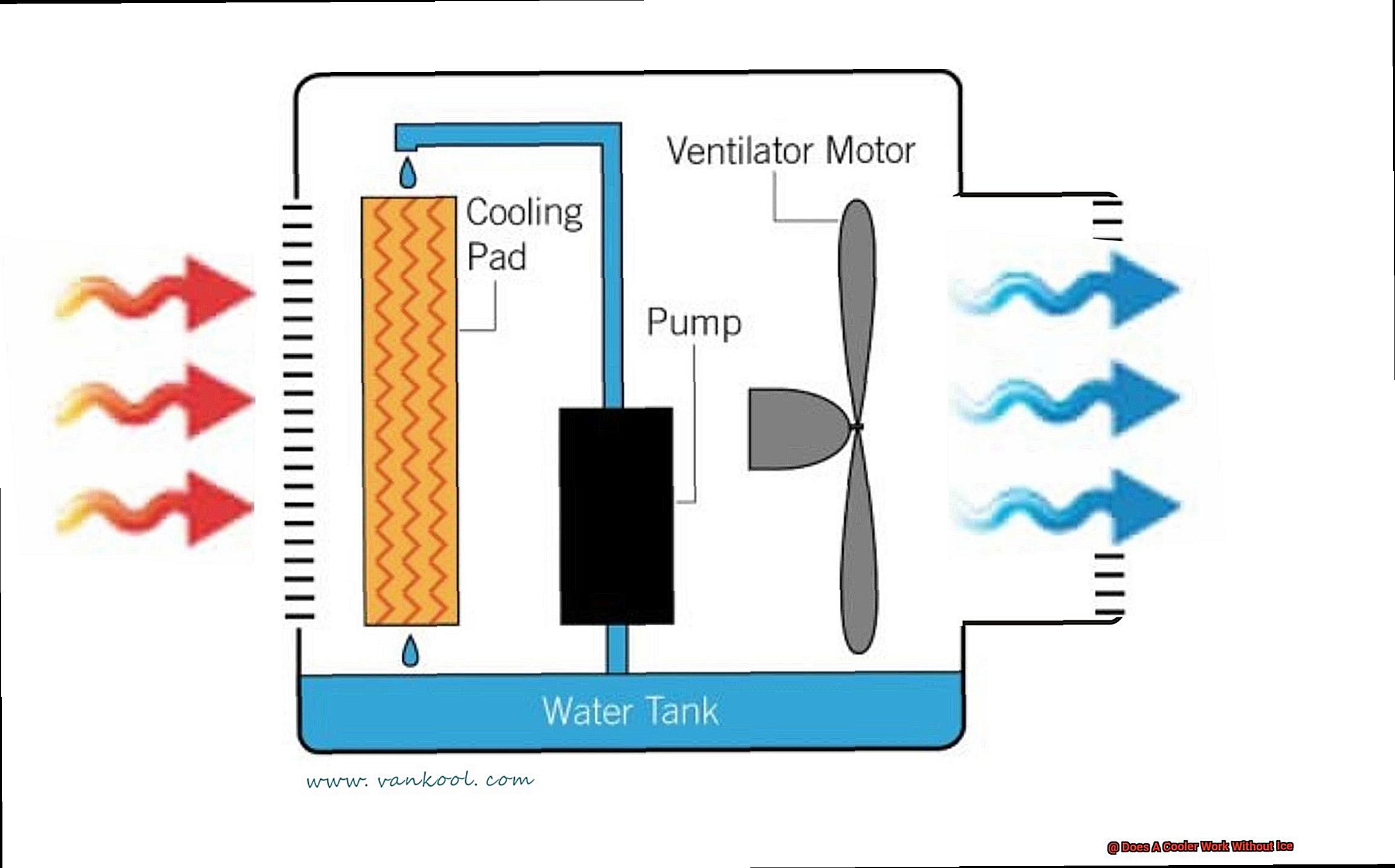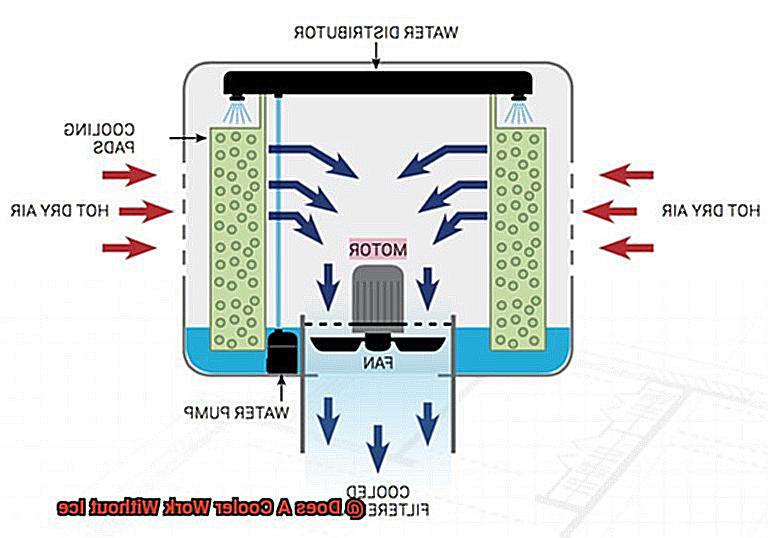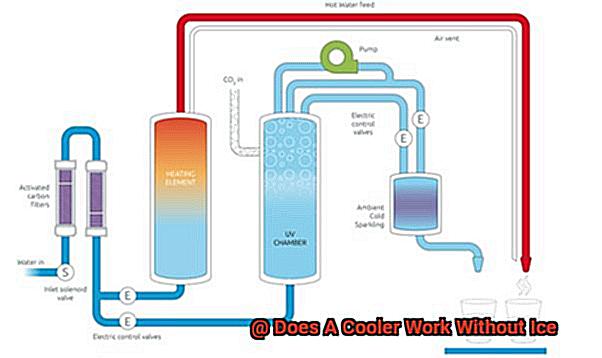Are you an outdoor enthusiast who loves to explore nature or hit the beach with chilled drinks and snacks?
If yes, then a cooler is a must-have item for you. Coolers are designed to keep your food and beverages cold, making them perfect for picnics, parties, and outdoor adventures.
But have you ever wondered if your cooler can work without ice? Well, wonder no more.
I’m here to answer all your questions about whether a cooler can work without ice. In this blog post, I’ll debunk common myths about coolers, explain how heat transfer works, and show you how to keep your cooler cold without ice using alternative techniques.
Whether you’re planning a camping trip, backyard BBQ, or beach getaway, you want your canned drinks and snacks at the perfect temperature. That’s why it’s essential to know how to keep your cooler cold without ice.
So, let’s dive in now.
Contents
Does A Cooler Work Without Ice?
Well, the answer is not as straightforward as you might think.
It depends on what you mean by “work.” Let’s explore this question and find out more.
First of all, a cooler’s primary function is to insulate the contents from the surrounding temperature. When you add ice, it helps to maintain the temperature inside the cooler and keep items cold for an extended period.
However, without ice, the cooler will eventually reach equilibrium with the outside temperature, causing your items to warm up gradually over time. So, if you only need to keep things cool for a short period, a cooler without ice could work just fine.
But wait, there’s more to consider. The type of cooler you have also makes a difference.
Some coolers are designed to keep things cold without ice, such as electric coolers or those that use special insulation materials. These types of coolers can be more expensive than traditional ice-filled coolers, but they are worth considering if you want a long-term cooling solution without the hassle of handling ice.
If you don’t want to use ice, there are alternative cooling methods available. Dry ice is an excellent option as it lasts longer and can keep your cooler colder for an extended period.
However, you need to handle dry ice with care as it can be dangerous if not treated properly. Gel packs are another popular alternative that can be reused and refrozen multiple times.
They come in various sizes and shapes, making them easy to fit into any size cooler. Finally, pre-chilling your items before placing them in the cooler is another smart way to keep your cooler cool without ice.
This method helps to reduce the initial temperature of your items before placing them in the cooler and can extend their shelf life. In conclusion, whether a cooler works without ice depends on your needs and the type of cooler you have.
However, if you only need to keep things cool for a short period, a well-insulated cooler without ice could work just fine.

Alternatives To Ice: Dry Ice

This frozen form of carbon dioxide has gained popularity in recent years because of its effectiveness in keeping items cool. One significant advantage of dry ice is that it doesn’t melt like regular ice, which means you won’t have to deal with any water accumulation in your cooler.
However, it’s important to handle dry ice with care as it can be hazardous if not handled properly. This means wearing gloves when handling it and never touching it with bare skin.
It’s also crucial to keep safety precautions in mind when using dry ice in a cooler. For example, never use dry ice in an enclosed space as it can displace oxygen and cause suffocation.
Instead, pack your cooler with layers of insulation such as blankets or towels to keep the cold air inside. Another factor to keep in mind is the amount of dry ice you use.
Too much dry ice can freeze your items solid, rendering them unusable. So, be mindful of how much you use and adjust accordingly.
Overall, dry ice is an excellent alternative to traditional ice for those who want to keep their items cool for longer periods of time. With proper handling and safety precautions, you can enjoy the benefits of using dry ice without any issues.
Alternatives To Ice: Gel Packs
If you’re tired of the mess and fuss that comes with using ice in your cooler, then gel packs are the answer.
These polymer gel packs freeze and stay cold for longer than ice, making them a great alternative to keep your cooler chilly. One of the main advantages of gel packs is that they don’t melt like ice, meaning less mess and no soggy food or drinks.
Additionally, they’re reusable, which saves you money in the long run as you won’t have to keep buying bags of ice. Gel packs come in various sizes and shapes, making them a versatile addition to any cooler.
However, it’s important to note that they may not be as effective as ice at keeping your cooler cool, especially if you’re using a larger cooler or planning to be out for an extended period. So, make sure to use them along with pre-chilled items and consider the size of your cooler and how long you’ll be outdoors.
Using gel packs is simple, just freeze them solid before placing them in your cooler alongside your food and beverages. To maximize their effectiveness, be sure to chill your items beforehand.
Not only are they mess-free and reusable, but they also come in various colors and shapes.
Alternatives To Ice: Pre-Chilling Items
Here’s a solution – pre-chilling your items before placing them in the cooler.
By refrigerating or freezing your food ahead of time, you’ll allow it to reach a lower temperature before being added to the cooler. This simple step will help to keep your food cool for longer and reduce the need for ice.
Think of it like giving your food a cold head start. For instance, if you’re packing drinks for a camping trip or picnic, you can chill them in the fridge or freezer before adding them to the cooler.
This will help keep them cold for an extended period and reduce ice usage. Similarly, pre-chilling food items such as sandwiches, fruit, and vegetables by storing them in the fridge before packing them in the cooler can also help.
Another alternative to traditional ice is frozen gel packs or reusable ice packs. These nifty packs can be frozen and added to the cooler, keeping your items cool without creating a mess.
Additionally, they’re reusable and won’t melt like traditional ice, making them an excellent choice. It’s worth noting that pre-chilling items or using frozen gel packs may not keep your food as cold as traditional ice would.
However, they can still be effective at keeping your items cool for a decent amount of time. To ensure optimal cooling, pack your cooler correctly by tightly packing items together and minimizing air space.
It reduces the need for ice while keeping your items cool for longer periods of time.
Benefits Of Using Alternatives To Ice In A Cooler
When it comes to keeping your food and drinks cold during a picnic or camping trip, ice is the common choice.
However, have you ever considered using alternatives to ice in your cooler? Not only can these options be just as effective, but they also offer several benefits that traditional ice cannot.
Firstly, alternatives like frozen gel packs or dry ice can last much longer than regular ice, especially in hot weather. This means that you can keep your food and drinks cold for extended periods without worrying about constantly refilling the cooler with new ice.
Plus, these alternatives won’t create a mess in your cooler since they don’t melt into water. Moreover, using alternatives to ice also means more space in your cooler for food and drinks.
Traditional ice takes up a lot of space and can limit what you can pack in the cooler. With alternatives like frozen gel packs or dry ice, you have more room for your favorite snacks and beverages.
Additionally, these alternatives are versatile and can keep items frozen as well as cold. Lastly, choosing alternatives to ice in your cooler can be eco-friendly.
Reusable gel packs or ice packs can be used multiple times, reducing waste and benefiting the environment. In conclusion, there are many benefits to using alternatives to ice in your cooler.
Whether you’re looking for something longer lasting, less messy, more versatile, or more environmentally friendly, there are plenty of options available.
Jj8472s0O1M” >
How To Handle Dry Ice Safely
Dry ice is a fantastic alternative to regular ice for keeping your cooler cold. It’s important to treat dry ice with caution because it’s extremely cold and can cause injury if not handled properly. Here are some tips for safe handling of dry ice.
Protect Your Hands
Dry ice is so cold that it can cause frostbite if it comes into contact with your skin. Hence, always protect your hands by wearing gloves or using tongs when handling dry ice. This will help you avoid any potential hazards while using it in your cooler.
Fresh Air Breaths
When using dry ice in a cooler, it’s essential to ensure that there is adequate ventilation. As dry ice evaporates, it releases carbon dioxide gas, which can build up and cause the cooler to explode if it is not allowed to escape. Therefore, make sure your cooler has a vent or leave the lid slightly open.
Keep Your Cool.
Direct contact with dry ice can damage your food or drinks. To avoid this, wrap the dry ice in a towel or newspaper and place it on top of the items in the cooler. This will prevent direct contact and allow for better distribution of the cold temperature.
Careful Disposal
It’s crucial to dispose of dry ice properly as it can be hazardous if not disposed of correctly. Never throw dry ice in the garbage or pour it down the drain as this can cause damage. Instead, let it vaporize in a well-ventilated area or return it to the place of purchase.
Possibilities in the Icy World
By following these safety precautions, using dry ice in a cooler can be a safe and effective way to keep items cold for an extended period of time. With these tips in mind, you can enjoy all the benefits that dry ice has to offer without fear of any potential hazards.
Also Read: How to Keep Ribs Warm After Cooking – Pastime Bar And Grill
Conclusion
To sum it up, a cooler can function without ice depending on your preferences and the type of cooler you own.
If you’re looking for a short-term cooling solution, a well-insulated cooler without ice can do the trick. However, if you want to keep things cool for an extended period without worrying about handling ice, electric coolers or those with special insulation materials are worth considering.
Dry ice and gel packs are excellent alternatives to traditional ice because they last longer, don’t create a mess, and leave more space in your cooler. Another smart approach is to pre-chill your items before placing them in the cooler.
If you opt for dry ice, it’s crucial to handle it safely by wearing gloves or using tongs, ensuring proper ventilation, wrapping it in a towel or newspaper before putting it on top of items in the cooler, and disposing of it correctly. By following these safety guidelines, using dry ice in a cooler can be an effective and secure way to keep items cold for an extended period.
Ultimately, whether you choose regular ice or substitutes such as gel packs or dry ice depends on what suits your needs best.






